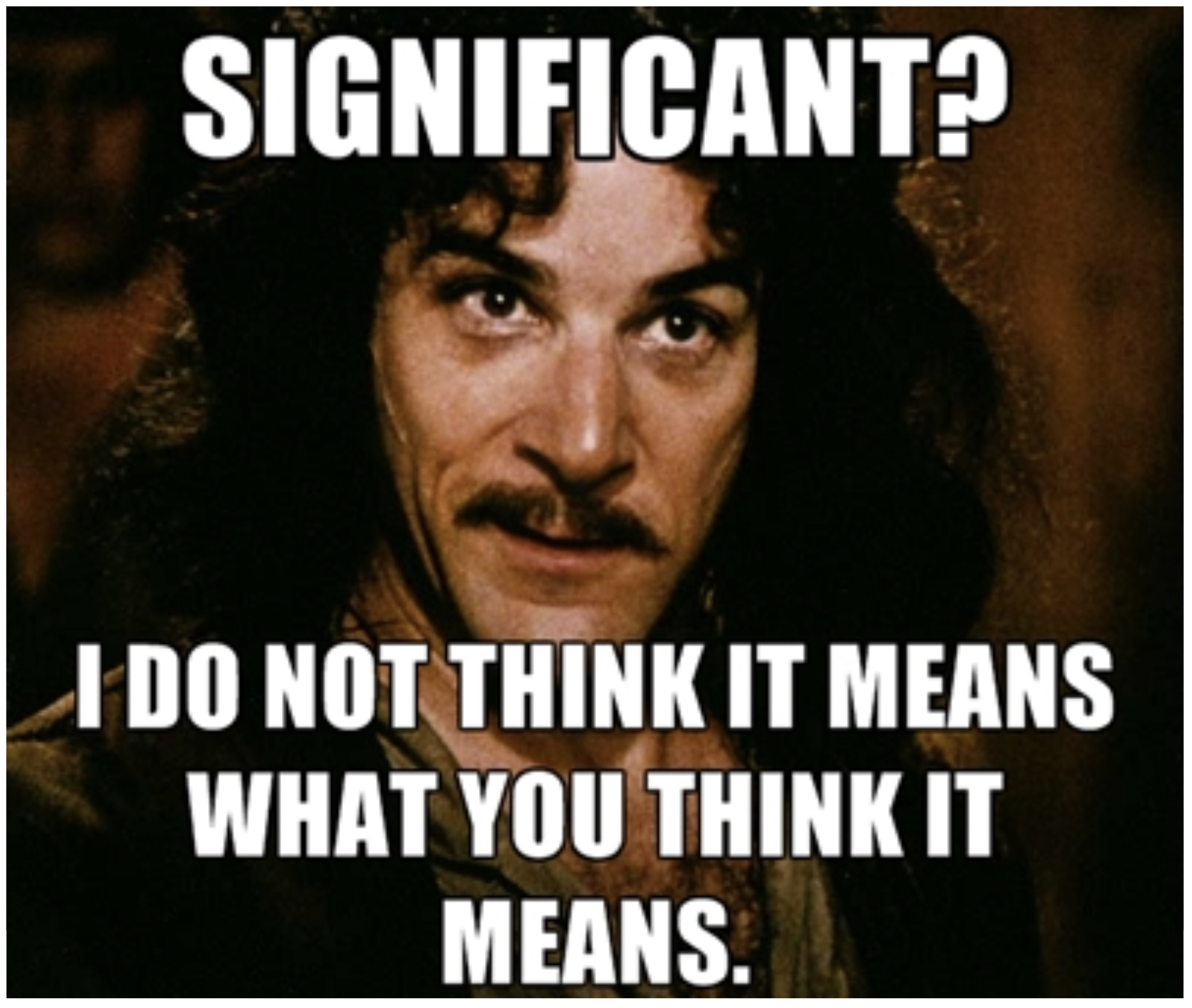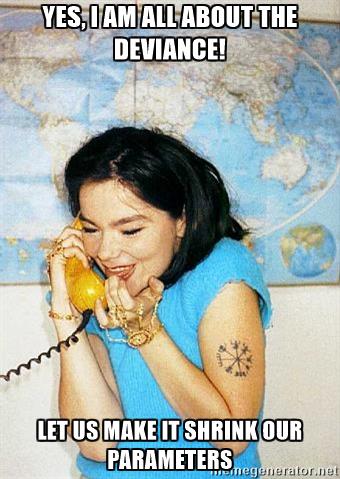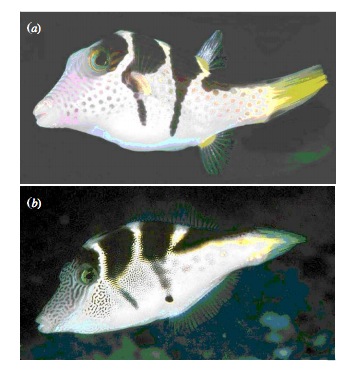class: center # Frequentist Tests of Statistical Models  --- ## Making P-Values with Models 1. Linear Models 2. Generalized Linear Models & Likelihood 3. Mixed Models --- # Common Regression Test Statistics - Are my coefficients 0? - **Null Hypothesis**: Coefficients are 0 - **Test Statistic**: T distribution (normal distribution modified for low sample size) -- - Does my model explain variability in the data? - **Null Hypothesis**: The ratio of variability from your predictors versus noise is 1 - **Test Statistic**: F distribution (describes ratio of two variances) --- background-image: url(images/09/guiness_full.jpg) background-position: center background-size: contain background-color: black --- background-image: url(images/09/gosset.jpg) background-position: center background-size: contain --- # T-Distributions are What You'd Expect Sampling a Standard Normal Population with a Small Sample Size - t = mean/SE, DF = n-1 - It assumes a normal population with mean of 0 and SD of 1 <img src="freq_testing_files/figure-html/dist_shape_t-1.png" style="display: block; margin: auto;" /> --- # Assessing the Slope with a T-Test <br> `$$\Large t_{b} = \frac{b - \beta_{0}}{SE_{b}}$$` #### DF=n-2 `\(H_0: \beta_{0} = 0\)`, but we can test other hypotheses --- # Slope of Puffer Relationship (DF = 1 for Parameter Tests) | | Estimate| Std. Error| t value| Pr(>|t|)| |:-----------|--------:|----------:|-------:|------------------:| |(Intercept) | 1.925| 1.506| 1.278| 0.218| |resemblance | 2.989| 0.571| 5.232| 0.000| <Br> p is **very** small here so... We reject the hypothesis of no slope for resemblance, but fail to reject it for the intercept. --- # So, what can we say in a null hypothesis testing framework? .pull-left[ - We reject that there is no relationship between resemblance and predator visits in our experiment. - 0.6 of the variability in predator visits is associated with resemblance. ] .pull-right[ <img src="freq_testing_files/figure-html/puffershow-1.png" style="display: block; margin: auto;" /> ] --- # Does my model explain variability in the data? Ho = The model predicts no variation in the data. Ha = The model predicts variation in the data. -- To evaluate these hypotheses, we need to have a measure of variation explained by data versus error - the sums of squares! -- This is an Analysis of Variance..... **ANOVA**! -- `$$SS_{Total} = SS_{Regression} + SS_{Error}$$` --- # Sums of Squares of Error, Visually <img src="freq_testing_files/figure-html/linefit-1.png" style="display: block; margin: auto;" /> --- # Sums of Squares of Regression, Visually <img src="freq_testing_files/figure-html/ssr-1.png" style="display: block; margin: auto;" /> Distance from `\(\hat{y}\)` to `\(\bar{y}\)` --- # Components of the Total Sums of Squares `\(SS_{R} = \sum(\hat{Y_{i}} - \bar{Y})^{2}\)`, df=1 `\(SS_{E} = \sum(Y_{i} - \hat{Y}_{i})^2\)`, df=n-2 -- To compare them, we need to correct for different DF. This is the Mean Square. MS=SS/DF e.g, `\(MS_{E} = \frac{SS_{E}}{n-2}\)` --- # The F Distribution and Ratios of Variances `\(F = \frac{MS_{R}}{MS_{E}}\)` with DF=1,n-2 <img src="freq_testing_files/figure-html/f-1.png" style="display: block; margin: auto;" /> --- # F-Test and Pufferfish | | Df| Sum Sq| Mean Sq| F value| Pr(>F)| |:-----------|--:|--------:|----------:|--------:|--------:| |resemblance | 1| 255.1532| 255.153152| 27.37094| 5.64e-05| |Residuals | 18| 167.7968| 9.322047| NA| NA| <br><br> -- We reject the null hypothesis that resemblance does not explain variability in predator approaches --- # Testing the Coefficients - F-Tests evaluate whether elements of the model contribute to variability in the data - Are modeled predictors just noise? - What's the difference between a model with only an intercept and an intercept and slope? -- - T-tests evaluate whether coefficients are different from 0 -- - Often, F and T agree - but not always - T can be more sensitive with multiple predictors --- # What About Models with Categorical Variables? - T-tests for Coefficients with Treatment Contrasts - F Tests for Variability Explained by Including Categorical Predictor - **ANOVA** - More T-Tests for Posthoc Evaluation --- # What Explains This Data? Same as Regression (because it's all a linear model) <img src="freq_testing_files/figure-html/brain_anova_viz_1-1.png" style="display: block; margin: auto;" /> --- # Variability due to Model (between groups) <img src="freq_testing_files/figure-html/brain_anova_viz_2-1.png" style="display: block; margin: auto;" /> --- # Variability due to Error (Within Groups) <img src="freq_testing_files/figure-html/brain_anova_viz_3-1.png" style="display: block; margin: auto;" /> --- # F-Test to Compare <br><br> `\(SS_{Total} = SS_{Model} + SS_{Error}\)` -- (Classic ANOVA: `\(SS_{Total} = SS_{Between} + SS_{Within}\)`) -- Yes, these are the same! --- # F-Test to Compare `\(SS_{Model} = \sum_{i}\sum_{j}(\bar{Y_{i}} - \bar{Y})^{2}\)`, df=k-1 `\(SS_{Error} = \sum_{i}\sum_{j}(Y_{ij} - \bar{Y_{i}})^2\)`, df=n-k To compare them, we need to correct for different DF. This is the Mean Square. MS = SS/DF, e.g, `\(MS_{W} = \frac{SS_{W}}{n-k}\)` --- # ANOVA | | Df| Sum Sq| Mean Sq| F value| Pr(>F)| |:---------|--:|---------:|---------:|--------:|---------:| |group | 2| 0.5402533| 0.2701267| 7.823136| 0.0012943| |Residuals | 42| 1.4502267| 0.0345292| NA| NA| We have strong confidence that we can reject the null hypothesis --- # This Works the Same for Multiple Categorical TreatmentHo: `\(\mu_{i1} = \mu{i2} = \mu{i3} = ...\)` Block Ho: `\(\mu_{j1} = \mu{j2} = \mu{j3} = ...\)` i.e., The variance due to each treatment type is no different than noise --- # We Decompose Sums of Squares for Multiple Predictors `\(SS_{Total} = SS_{A} + SS_{B} + SS_{Error}\)` - Factors are Orthogonal and Balanced, so, Model SS can be split - F-Test using Mean Squares as Before --- # What About Unbalanced Data or Mixing in Continuous Predictors? - Let's Assume Y ~ A + B where A is categorical and B is continuous -- - F-Tests are really model comparisons -- - The SS for A is the Residual SS of Y ~ A + B - Residual SS of Y ~ B - This type of SS is called **marginal SS** or **type II SS** -- - Proceed as normal -- - This also works for interactions, where interactions are all tested including additive or lower-level interaction components - e.g., SS for AB is RSS for A+B+AB - RSS for A+B --- # Warning for Working with SAS Product Users (e.g., JMP) - You will sometimes see *Type III* which is sometimes nonsensical - e.g., SS for A is RSS for A+B+AB - RSS for B+AB -- - Always question the default settings! --- class:center, middle # F-Tests tell you if you can reject the null that predictors do not explain anything --- # Post-Hoc Comparisons of Groups - **Only compare groups if you reject a Null Hypothesis via F-Test** - Otherwise, any results are spurious - This is why they are called post-hocs -- - We've been here before with SEs and CIs -- - In truth, we are using T-tests -- - BUT - we now correct p-values for Family-Wise Error (if at all) --- ## Making P-Values with Models 1. Linear Models 2. .red[Generalized Linear Models & Likelihood] 3. Mixed Models --- # To Get There to Testing, We Need To Understand Likelihood and Deviance .center[  --- class: middle # Likelihood: how well data support a given hypothesis. -- ### Note: Each and every parameter choice IS a hypothesis --- # Likelihood Defined <br><br> `$$\Large L(H | D) = p(D | H)$$` Where the D is the data and H is the hypothesis (model) including a both a data generating process with some choice of parameters (often called `\(\theta\)`). The error generating process is inherent in the choice of probability distribution used for calculation. --- class: middle ## The Maximum Likelihood Estimate is the value at which `\(p(D | \theta)\)` - our likelihood function - is highest. -- #### To find it, we search across various values of `\(\theta\)` --- # MLE for Multiple Data Points Let's say this is our data: ``` [1] 3.37697212 3.30154837 1.90197683 1.86959410 0.20346568 3.72057350 [7] 3.93912102 2.77062225 4.75913135 3.11736679 2.14687718 3.90925918 [13] 4.19637296 2.62841610 2.87673977 4.80004312 4.70399588 -0.03876461 [19] 0.71102505 3.05830349 ``` -- We know that the data comes from a normal population with a `\(\sigma\)` of 1.... but we want to get the MLE of the mean. -- `\(p(D|\theta) = \prod p(D_i|\theta)\)` -- = `\(\prod dnorm(D_i, \mu, \sigma = 1)\)` --- # Likelihood At Different Choices of Mean, Visually <img src="freq_testing_files/figure-html/ml_search-1.png" style="display: block; margin: auto;" /> --- # The Likelihood Surface <img src="freq_testing_files/figure-html/lik_mean_surf-1.png" style="display: block; margin: auto;" /> MLE = 2.896 --- # The Log-Likelihood Surface We use Log-Likelihood as it is not subject to rounding error, and approximately `\(\chi^2\)` distributed. <img src="freq_testing_files/figure-html/loglik_surf-1.png" style="display: block; margin: auto;" /> --- # The `\(\chi^2\)` Distribution - Distribution of sums of squares of k data points drawn from N(0,1) - k = Degrees of Freedom - Measures goodness of fit - A large probability density indicates a match between the squared difference of an observation and expectation --- # The `\(\chi^2\)` Distribution, Visually <img src="freq_testing_files/figure-html/chisq_dist-1.png" style="display: block; margin: auto;" /> --- # Hey, Look, it's the Standard Error! The 68% CI of a `\(\chi^2\)` distribution is 0.49, so.... <img src="freq_testing_files/figure-html/loglik_zoom-1.png" style="display: block; margin: auto;" /> --- # Hey, Look, it's the 95% CI! The 95% CI of a `\(\chi^2\)` distribution is 1.92, so.... <img src="freq_testing_files/figure-html/ll_ci-1.png" style="display: block; margin: auto;" /> --- # The Deviance: -2 * Log-Likelihood - Measure of fit. Smaller deviance = closer to perfect fit - We are minimizing now, just like minimizing sums of squares - Point deviance residuals have meaning - Point deviance of linear regression = mean square error! <img src="freq_testing_files/figure-html/show_dev-1.png" style="display: block; margin: auto;" /> --- # Putting MLE Into Practice with Pufferfish .pull-left[ - Pufferfish are toxic/harmful to predators <br> - Batesian mimics gain protection from predation - why? <br><br> - Evolved response to appearance? <br><br> - Researchers tested with mimics varying in toxic pufferfish resemblance ] .pull-right[  ] --- # This is our fit relationship <img src="freq_testing_files/figure-html/puffershow-1.png" style="display: block; margin: auto;" /> --- # Likelihood Function for Linear Regression <br><br><br> <center>Will often see:<br><br> `\(\large L(\theta | D) = \prod_{i=1}^n p(y_i\; | \; x_i;\ \beta_0, \beta_1, \sigma)\)` </center> --- # Likelihood Function for Linear Regression: What it Means <br><br> `$$L(\theta | Data) = \prod_{i=1}^n \mathcal{N}(Visits_i\; |\; \beta_{0} + \beta_{1} Resemblance_i, \sigma)$$` <br><br> where `\(\beta_{0}, \beta_{1}, \sigma\)` are elements of `\(\theta\)` --- # The Log-Likelihood Surface from Grid Sampling <img src="freq_testing_files/figure-html/reg_lik_surf-1.png" style="display: block; margin: auto;" /> --- # Let's Look at Profiles to get CIs <img src="freq_testing_files/figure-html/profileR-1.png" style="display: block; margin: auto;" /> --- # Evaluate Coefficients <table class="table table-striped" style="margin-left: auto; margin-right: auto;"> <thead> <tr> <th style="text-align:left;"> term </th> <th style="text-align:right;"> estimate </th> <th style="text-align:right;"> std.error </th> <th style="text-align:right;"> statistic </th> <th style="text-align:right;"> p.value </th> </tr> </thead> <tbody> <tr> <td style="text-align:left;"> (Intercept) </td> <td style="text-align:right;"> 1.925 </td> <td style="text-align:right;"> 1.506 </td> <td style="text-align:right;"> 1.278 </td> <td style="text-align:right;"> 0.218 </td> </tr> <tr> <td style="text-align:left;"> resemblance </td> <td style="text-align:right;"> 2.989 </td> <td style="text-align:right;"> 0.571 </td> <td style="text-align:right;"> 5.232 </td> <td style="text-align:right;"> 0.000 </td> </tr> </tbody> </table> <br> Test Statistic is a Wald Z-Test Assuming a well behaved quadratic Confidence Interval --- class: center, middle # What about comparing models, or evaluating if variables (continuous or categorical) should be included? --- # Can Compare p(data | H) for alternate Parameter Values - and it could be 0! <img src="freq_testing_files/figure-html/likelihoodDemo3-1.png" style="display: block; margin: auto;" /> Compare `\(p(D|\theta_{1})\)` versus `\(p(D|\theta_{2})\)` --- ## Likelihood Ratios <br> `$$\LARGE G = \frac{L(H_1 | D)}{L(H_2 | D)}$$` - G is the ratio of *Maximum Likelihoods* from each model -- - Used to compare goodness of fit of different models/hypotheses -- - Most often, `\(\theta\)` = MLE versus `\(\theta\)` = 0 -- - `\(-2 log(G)\)` is `\(\chi^2\)` distributed --- # Likelihood Ratio Test - A new test statistic: `\(D = -2 log(G)\)` -- - `\(= 2 [Log(L(H_2 | D)) - Log(L(H_1 | D))]\)` -- - We then scale by *dispersion parameter* (e.g., variance, etc.) -- - It's `\(\chi^2\)` distributed! - DF = Difference in # of Parameters -- - If `\(H_1\)` is the Null Model, we have support for our alternate model --- # Likelihood Ratio Test for Regression - We compare our slope + intercept to a model fit with only an intercept! - Note, models must have the SAME response variable ```r int_only <- glm(predators ~ 1, data = puffer) ``` -- - We then use *Analysis of Deviance* (ANODEV) --- # Our First ANODEV ``` Analysis of Deviance Table Model 1: predators ~ 1 Model 2: predators ~ resemblance Resid. Df Resid. Dev Df Deviance Pr(>Chi) 1 19 422.95 2 18 167.80 1 255.15 1.679e-07 *** --- Signif. codes: 0 '***' 0.001 '**' 0.01 '*' 0.05 '.' 0.1 ' ' 1 ``` Note, uses Difference in Deviance / Dispersion where Dispersion = Variance as LRT --- # Or, R has Tools to Automate Doing This Piece by Piece ``` Analysis of Deviance Table (Type II tests) Response: predators LR Chisq Df Pr(>Chisq) resemblance 27.371 1 1.679e-07 *** --- Signif. codes: 0 '***' 0.001 '**' 0.01 '*' 0.05 '.' 0.1 ' ' 1 ``` Here, LRT = Difference in Deviance / Dispersion where Dispersion = Variance --- ## Making P-Values with Models 1. Linear Models 2. Generalized Linear Models & Likelihood 3. .red[Mixed Models] --- # Let's take this to the beach with Tide Height: RIKZ  --- # How is Tidal Height of Measurement Associated With Species Richness? <img src="freq_testing_files/figure-html/plot_varint-1.png" style="display: block; margin: auto;" /> --- class: center, middle ## Before we go any further - keep up to date at ### https://bbolker.github.io/mixedmodels-misc/glmmFAQ.html#testing-hypotheses --- class: center, middle ## The Big Question: What are your degrees of freedom in the presence of a random effect? --- ## Approaches to approximating DF - Satterthwaite approximation - Based on sample sizes and variances within groups - `lmerTest` (which is kinda broken at the moment) - Kenward-Roger’s approximation. - Based on estimate of variance-covariance matrix of fixed effects and a scaling factor - More conservative - in `car::Anova()` and `pbkrtest` --- # Compare! Baseline - only for balanced LMMs! ``` Analysis of Variance Table npar Sum Sq Mean Sq F value NAP 1 10.467 10.467 63.356 ``` Satterwaith ``` Type III Analysis of Variance Table with Satterthwaite's method Sum Sq Mean Sq NumDF DenDF F value Pr(>F) NAP 10.467 10.467 1 37.203 63.356 1.495e-09 *** --- Signif. codes: 0 '***' 0.001 '**' 0.01 '*' 0.05 '.' 0.1 ' ' 1 ``` Kenward-Roger ``` Analysis of Deviance Table (Type II Wald F tests with Kenward-Roger df) Response: log_richness F Df Df.res Pr(>F) NAP 62.154 1 37.203 1.877e-09 *** --- Signif. codes: 0 '***' 0.001 '**' 0.01 '*' 0.05 '.' 0.1 ' ' 1 ``` --- ## The Smaller Questions and Answers 1. With REML (for lmms), we often are conservative in our estimation of fixed effects. Should we use it? - use ML for FE tests if using Chisq -- 2. Should we use Chi-Square? - for GLMMs, yes. - Can be unreliable in some scenarios. - Use F tests for lmms --- # F and Chisq F-test ``` # A tibble: 1 × 5 term statistic df Df.res p.value <chr> <dbl> <dbl> <dbl> <dbl> 1 NAP 62.2 1 37.2 0.00000000188 ``` LR Chisq ``` # A tibble: 1 × 4 term statistic df p.value <chr> <dbl> <dbl> <dbl> 1 NAP 63.4 1 1.72e-15 ``` -- LR Chisq where REML = FALSE ``` # A tibble: 1 × 4 term statistic df p.value <chr> <dbl> <dbl> <dbl> 1 NAP 65.6 1 5.54e-16 ``` --- ## What about Random Effects - For LMMs, make sure you have fit with REML = TRUE -- - One school of thought is to leave them in place - Your RE structure should be determined by sampling design - Do you know enough to change your RE structure? -- - But sometimes you need to test! - Can sequentially drop RE effects with `lmerTest::ranova()` - Can simulate models with 0 variance in RE with `rlrsim`, but gets tricky --- ## RANOVA ```r ranova(rikz_varint) ``` ``` ANOVA-like table for random-effects: Single term deletions Model: log_richness ~ NAP + (1 | Beach) npar logLik AIC LRT Df Pr(>Chisq) <none> 4 -32.588 73.175 (1 | Beach) 3 -38.230 82.460 11.285 1 0.0007815 *** --- Signif. codes: 0 '***' 0.001 '**' 0.01 '*' 0.05 '.' 0.1 ' ' 1 ``` --- ## Testing Mixed Models 1. Yes you can! -- 2. Some of the fun issues of denominator DF raise their heads -- 3. Keep up to date on the literature/FAQ when you are using them! --- class: center, middle 